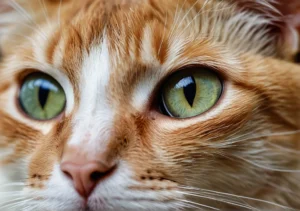Cats have a unique way of perceiving the world around them, but have you ever wondered why they can’t see fire the same way humans do? Let’s explore the fascinating reasons behind this curious phenomenon.
Differences in Retinas
Cats and humans see the world in unique ways due to differences in their retinas. Cats have more rod cells and fewer cone cells in their retinas compared to humans. Rod cells are responsible for low-light vision, while cone cells are essential for color vision. Since cats have a higher number of rod cells, they excel in night vision but have limited color perception during the day.
Moreover, cats have a specialized reflective layer behind their retinas called the tapetum lucidum. This layer enhances their night vision but can cause them to be more sensitive to bright light sources like fire. The combination of these factors means that cats perceive fire differently than humans do, as their vision is optimized for hunting in low-light conditions rather than distinguishing between different colors and wavelengths of light.
Lack of Color Perception
Unlike humans, cats have limited color perception. While humans have three types of cones that allow us to see a wide range of colors, cats only have two types of cones. This means that cats see the world in variations of blue and yellow, without the ability to distinguish between red, green, and orange hues.
When it comes to fire, this lack of color perception impacts how cats perceive flames. While humans see the vibrant red, orange, and yellow colors of fire, cats see a more muted version of these colors. This can make it harder for cats to identify dangerous situations involving fire, as the visual cues they rely on differ from those of humans.
Additional Tip:
To cater to your cat’s limited color perception, consider using scented candles or natural flame colorants to make fire sources easier for them to notice and avoid. This extra step can help keep your furry friend safe around flames.
Sensitivity to Bright Lights
Cats have a unique sensitivity to bright lights compared to humans. This heightened sensitivity is due to the structure of their eyes, particularly the specialized cells in their retinas called rod cells. These rod cells are highly sensitive to light, allowing cats to see well in low-light conditions but making bright lights, such as fire, overwhelming for their sensitive eyes.
In addition, cats have a reflective layer behind their retinas called the tapetum lucidum. This layer enhances their night vision by reflecting light back through the retina, giving their eyes a glowing appearance in the dark. However, this same layer can also amplify the intensity of bright lights, like fire, making them appear even brighter and potentially discomforting for cats.
Night Vision Adaptations
Cats are crepuscular animals, meaning they are most active during dawn and dusk when light levels are low. To adapt to these low-light conditions, cats have evolved specialized eye structures that enhance their night vision. For example, their large pupils can open wide to allow more light into their eyes, while their retinas contain a high density of rod cells, which are sensitive to dim light.
These adaptations allow cats to see well in near darkness, making them excellent hunters when most prey animals are active. However, these same adaptations can make bright lights, like fire, appear blinding to cats, as their eyes are not designed to handle such intense light sources.
Additional Insight: Factors Affecting Cat Vision
- Cats have a higher flicker fusion frequency than humans, which means they can detect rapid movements better but may struggle with rapidly flickering lights, such as flames.
- Cats also have a different range of color vision compared to humans, with a greater ability to see in low light but reduced ability to distinguish between certain colors.
Predator Instincts
Cats’ natural instincts as predators play a significant role in how they perceive fire and other sources of light. The eyes of cats are finely tuned to detect movements, especially in low light conditions, making them exceptional nighttime hunters. However, this heightened sensitivity to movement means that they may not focus as much on static objects like fire, which doesn’t move in the same way prey does.
Additionally, cats have a wide field of vision due to their long, horizontally-slitted pupils, allowing them to detect movements on the periphery. This unique eye structure helps them scan their surroundings for potential prey but may not be as effective in focusing on a stationary object like fire directly in front of them. Therefore, cats may not see fire the same way humans do because their visual priorities are different, geared towards hunting rather than observing static light sources.
Evolutionary Factors
The evolutionary history of cats has significantly shaped their vision and perception of the world around them, including fire. Cats are crepuscular hunters, meaning they are most active during dawn and dusk when light levels are low. This evolutionary adaptation has influenced their vision, making them highly sensitive to low light conditions but less attuned to bright, steady light sources like fire.
Furthermore, cats have a higher concentration of rod cells in their retinas compared to cone cells, enhancing their night vision capabilities but reducing their ability to see colors and distinguish detailed shapes in bright light. This means that while cats may see movement and light shifts well, their perception of vivid, steady flames might be less clear compared to humans who have a greater color range and visual acuity under bright light conditions.
- Cats’ tapetum lucidum, a reflective layer behind their retinas, improves their night vision but can cause a glare effect around bright lights like fire, potentially distorting their perception.
- Unlike humans, cats have a higher tolerance for flickering or rapidly changing light, which is why they may show interest in flames’ movements rather than the flames themselves.
In conclusion, cats’ unique predator instincts and evolutionary adaptations have shaped their vision in a way that differs from humans, influencing how they perceive fire and other sources of light in their environment.
Behavioral Responses
Cats’ unique vision affects how they perceive fire compared to humans. They may not see fire the same way we do, which impacts their behavior around flames. Due to their limited color vision and focus on movement, cats may not fully recognize the danger of fire as humans do. This means they might not instinctively avoid it or react as quickly in a fire-related emergency. It’s essential to consider this when creating a safe environment for your feline friend.
Safety Considerations
Understanding cats’ vision and how they perceive fire is crucial for their safety. Since cats may not react to fire in the same way humans do, it’s essential to take extra precautions to protect them from potential hazards. This can include keeping flames safely contained, using flameless alternatives like LED candles, and ensuring your cat has easy access to escape routes in case of a fire emergency. By being aware of your cat’s unique perspective on fire, you can better safeguard their well-being in your home.
Tips for Fire Safety with Cats:
- Keep Flames Secured: Make sure candles, stoves, and fireplaces are out of reach for your cat.
- Use LED Candles: Opt for flameless alternatives to reduce the risk of fire-related accidents.
- Provide Escape Routes: Ensure your cat can easily exit the house in case of a fire emergency.
- Have a Fire Plan: Include your pets in your family’s fire safety plan to ensure everyone stays safe.
Fascinating Cat Facts
Did you know that cats have a unique way of seeing the world? While humans can see fire and distinguish colors in a wide spectrum, cats have some limitations in their vision. Cats are not color blind like dogs, but they can’t perceive colors as vividly as humans do. Their vision is more attuned to motion, which is why they are excellent hunters.
Another interesting fact about cats is their night vision. Cats have a higher number of rod cells in their eyes, which enable them to see clearly in low light conditions. This means that cats can navigate in the dark much better than humans can. It’s almost like having built-in night vision goggles!
When it comes to fire, cats see it differently due to their vision structure. Cats have a higher sensitivity to motion and lower resolution of details compared to humans. This means that cats may not see the flames or colors of fire as distinctly as we do. Their focus is on detecting movement and shapes rather than the nuances of fire.
In conclusion, while cats may not see fire the same way as humans, they have their own unique vision abilities that make them skilled hunters and agile night predators. Understanding these differences in vision can help us appreciate our feline friends even more.
- Tip: If you want to keep your cat safe from fire, make sure to pet-proof your home by using flameless candles and keeping fire sources out of reach.
I hope this sheds light on why cats see fire differently from humans!
Alex, a passionate animal lover, has experience in training and understanding animal behavior. As a proud pet parent to two dogs and three cats, he founded AnimalReport.net to share insights from animal experts and expand his knowledge of the animal kingdom.




